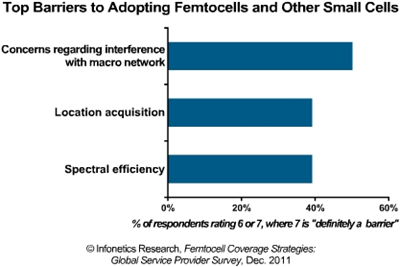英国ロンドン 2012年1月19日‐インフォネティクスリサーチ社から新たな分析結果 フェムトセルサービス地域戦略:グローバルサービスプロバイダー調査(Femtocell Coverage Strategies: Global Service Provider Survey)が発表された。フェムトセルなどのスモールセルの配備や、その種類、技術、タイミング、配置場所、屋内/屋外のバックホール技術、ドライバ、技術的課題、採用にあたっての障害、さらにモバイルトラフィックオフロード技術やプロトコルに至るまで、詳細に解説している。

アナリストノート
「このフェムトセルサービス地域戦略調査をするために、私たちはスモールセル(マイクロセル、ピコセル、および/または公共エリアでのフェムトセル)を配備している、もしくは2012年に配備しようと計画中の世界中の携帯電話会社にインタビューをしました。そのうち5社(28%)が既に公共エリアでのフェムトセルネットワークを商業ベースとして稼働させており、また半分の企業が今年中にそういったサービスを始める予定です。フェムトセルが元々ターゲットとしていた住宅地という市場以上に成長を続けていることは明らかで、公共エリアまでサービスを拡大しつつあり、「スモールセル」セットの一員になりつつあります。私たちは、世界のモバイル界の転換期の始まりに直面しているという事実が、私たちの調査に表れています。つまり、マクロ中心からマクロRANを改良した次世代スモールセル環境への移行しているのです。携帯電話会社はユビキタス社会を実現し、ユーザーの多い地域でも大容量を確保し、ブロードバンドを使用できるようにすることを目標としているのです。」 とインフォネティクスリサーチ社のマイクロ波、モバイルオフロード、モバイルブロードバンド機器主任アナリストのリチャード・ウェッブ(Richard Webb)は語っている。
フェムトセルサービス地域戦略調査のハイライト
- インフォネティクス社が調査をした携帯電話会社のうち83%が既にスモールセル(マイクロセルやピコセルが主流)を配備しており、調査に参加しているその他の企業も2012年の間には配備の予定である。
- ビル内のサービス範囲やデータの最適化は、フェムトセル/スモールセルを導入する企業向けのトップクラスのドライバで、新しくセルサイトを追加することが更に困難になったことによるマクロのネットワークの非拡張が続く。
- 携帯電話会社の61%が、スモールセルを配備した際にはマクロセルネットワークが最大の技術課題になるだろうと予測しているが、それがスモールセルを配備する際の大きな壁になる考えている企業は50%のみである。
- 公共エリアでのフェムトセル(別名「メトロフェムトセル」とも)を配備している携帯電話会社の割合は、2011年後半には28%だったが、2012年には44%まで成長し、ショッピングモールや空港、公共の建物といった人が多く行きかう広い場所でのモバイルサービスエリアと容量を拡大していく。
- キャリアWiFi(WiFiとモバイルネットワーク間をシームレスにするSIMベースのWiFiアクセスポイント)が伸びると、公共エリアフェムトセルがマクロネットワークからデータを転送する機会が妨げられてしまうかもしれない。
For its Femtocell Coverage Strategies: Global Service Provider Survey, Infonetics analysts interviewed 18 incumbent, mobile, and competitive operators that have deployed small cells or plan to in 2012. The respondents are from EMEA, Asia Pacific, and North America and together represent 30% of global telecom carrier revenue, 29% of global telecom carrier capex, and 20% of the world's mobile subscribers. The survey focuses on the deployment of small cells, microcells, picocells, and public femtocells. For a summary of Infonetics' coverage of consumer femtocells, please see its Residential Femtocell Services: Global Service Provider Survey highlights.
(原文)
Adoption of small cells / public space femtocells reflects a mobile world in transition
London, UK, January 19, 2012-A new study from market researcher Infonetics Research, Femtocell Coverage Strategies: Global Service Provider Survey, details mobile operator strategies for deploying femtocells and other small cells, including types, technologies, timing, installation locations, indoor and outdoor backhaul technologies, drivers, technical challenges, adoption barriers, and mobile traffic offload technologies and protocols.
ANALYST NOTE
"For our femtocell coverage strategies survey, we interviewed mobile operators from around the world that have deployed small cells (microcells, picocells, and/or public space femtocells) or plan to in 2012. Five (28%) are already running commercial public space femtocells networks, and almost half will do so sometime this year. Clearly, femtocells are growing beyond their original residential target market, moving into public space coverage, and becoming a full member of the 'small cells' set. Our survey reflects the fact that we are at the beginning of the mobile world's transition from macro-centric to the next generation environment of small cells augmenting the macro RAN as mobile operators attempt to deliver ubiquitous coverage and high capacity in areas of dense user population and high broadband usage," notes Richard Webb, directing analyst for microwave, mobile offload and mobile broadband devices at Infonetics Research.
FEMTOCELL COVERAGE STRATEGIES SURVEY HIGHLIGHTS
- 83% of mobile operators interviewed by Infonetics have already deployed small cells (predominantly microcells and picocells), and the remaining will deploy them by the end of 2012, a qualification for participating in the survey
- In-building coverage and data optimization are the top-rated drivers for operators deploying femtocells/small cells, followed by the non-expandability of the macro network due to the increasing difficulty of adding new cell sites
- Although 61% of the operators see potential interferences with the macrocell network as the top technical challenge when deploying small cells, only 50% rate it a strong barrier to adopting small cells
- The percentage of mobile operators deploying public space femtocells (also called "metro femtocells") is growing from 28% in late 2011 to 44% in 2012 to improve mobile coverage and capacity in large areas of high footfall, such as retail malls, airports, and public buildings
- The rise of carrier-WiFi (SIM-based WiFi access points that enable seamless handover between WiFi and cellular networks) could inhibit the opportunity for public space femtocells for offloading data from the macro network
- Femtocell market set to double in 2012, Airvana expands lead
- Operators turn to femtocells to improve enterprise coverage and capacity
- Small cell survey shows operators plan to run 12% of network capacity on small cells by 2012
- New study details operator plans for small cell backhaul
- Femtocell operator survey provides glimpse into the future of femtocell services
- Airvana jumps to top of femtocell leaderboard, market poised for explosive growth in 2012

